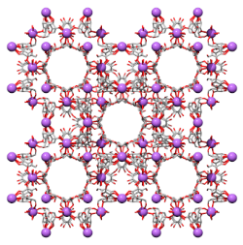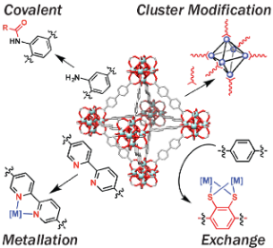The Forgan group is broadly interested in self-assembly, with current focus on metal-organic frameworks (MOFs). MOFs are self-assembled constructs wherein metal or metal cluster 'joints' link organic 'struts' to form highly interconnected hollow networks which often display permanent porosity. The ability to trap and store small molecules within MOFs leads to a number of potential applications.
For more information on our funding portfolio, click here.

Enhanced Reactivity and Properties in Porous Materials
Metal-organic frameworks contain arrays of ordered nanoscale pores which are often accessible to outside reagents by diffusion throughout the nanoporous network. Confining reagents within these 'molecular flasks' can dramatically alter their reactivity and regioselectivity, and facilitate their molecular sensing. The Forgan Group are exploiting this enhanced reactivity phenomenon to generate heterogeneous biomimetic catalysts - artificial enzymes - through extensive pore functionalisation and templated-directed synthesis. These studies (EPSRC grant EP/L004461/1) are underpinned by the Forgan Group's continuous investigations into the fundamentals of molecular recognition within MOFs themselves.
See: “Functional Versatility of a Series of Zr Metal-Organic Frameworks Probed by Solid-State Photoluminescence Spectroscopy” R. J. Marshall, Y. Kalinovskyy, S. L. Griffin, C. Wilson, B. A. Blight and R. S. Forgan, J. Am. Chem. Soc. 2017, 139, 6253–6260.
See: “Structure-Directing Factors when Introducing Hydrogen Bond Functionality to Metal-Organic Frameworks” R. S. Forgan, R. J. Marshall, M. Struckmann, A. B. Bleine, D. –L. Long, M. C. Bernini, D. Fairen-Jimenez, CrystEngComm 2015, 17, 299–306.



Drug Delivery from Functionalised Porous NanoMOFs
MOFs are being increasingly utilised to store and deliver molecular cargos to treat disease. The Forgan Group has developed a simple but effective methodology to produce bespoke, highly functionalised MOF nanoparticles to be used as targeted drug delivery vectors. In concert with our continuing interest in the interactions between MOF scaffolds and substrates, we aim to produce theranostic nanomaterials targeted at imaging and remedying specific ailments (ERC Starting Grant 677289).
See: “Surface-Functionalisation of Zr-Fumarate MOF for Selective Cytotoxicity and Immune System Compatibility in Nanoscale Drug Delivery” I. Abánades Lázaro, S. Haddad, J. Rodrigo-Muñoz, R. J. Marshall, B. Sastre, V. del Pozo, D. Fairen-Jimenez and R. S. Forgan, ACS Appl. Mater. Interfaces 2018, 10, 31146–31157.
See: “Enhancing Anticancer Cytotoxicity through Bimodal Drug Delivery from Ultrasmall Zr MOF Nanoparticles” I. Abánades Lázaro, S. Abánades Lázaro and R. S. Forgan, Chem. Commun. 2018, 54, 2792–2795.
See: “Selective Surface PEGylation of UiO-66 Nanoparticles for Enhanced Stability, Cell Uptake and pH Responsive Drug Delivery” I. Abánades Lázaro, S. Haddad, S. Sacca, C. Orellana-Tavra, D. Fairen-Jimenez and R. S. Forgan, Chem 2017, 2, 561–578.

Crystallisation and Mechanical Properties of High Valent MOFs
The Forgan group has conceived novel synthetic methodologies to enhance the crystallinity and control physical properties of high valent MOFs, allowing access to single crystals of otherwise unavailable MOFs. These breakthroughs have facilitated comprehensive studies of the MOFs under high pressure, elucidating mechanical properties, and led to the development of new postsynthetic modification protocols with applications in permanent sequestration of toxic gases.
See: “Controlling Interpenetration Through Linker Conformation in the Modulated Synthesis of Sc Metal–Organic Frameworks” R. J. Marshall, C. T. Lennon, A. Tao, H. M. Senn, C. Wilson, D. Fairen-Jimenez and R. S. Forgan, J. Mater. Chem. A 2018, 6, 1181–1187.
See: “Amino Acids as Highly Efficient Modulators for Single Crystals of Zirconium and Hafnium Metal-Organic Frameworks” R. J. Marshall, C. L. Hobday, C. F. Murphie, S. L. Griffin, C. A. Morrison, S. A. Moggach and R. S. Forgan, J. Mater. Chem. A 2016, 4, 6955–6963.
See: “Geometric Frustration in UiO Frameworks: A Computational and Experimental Approach Linking Disorder, High-Pressure Behaviour and Mechanical Properties” C. L. Hobday, R. J. Marshall, C. F. Murphie, J. Sotelo, T. Richards, D. Allan, T. Düren, F. –X. Coudert, R. S. Forgan, C. A. Morrison, S. A. Moggach and T. D. Bennett, Angew. Chem. Int. Ed. 2016, 55, 2401–2405.
See: “Single-Crystal to Single-Crystal Mechanical Contraction of Metal-Organic Frameworks through Stereoselective Post-Synthetic Bromination” R. J. Marshall, S. L. Griffin, C. Wilson and R. S. Forgan, J. Am. Chem. Soc. 2015, 137, 9527–9530.






